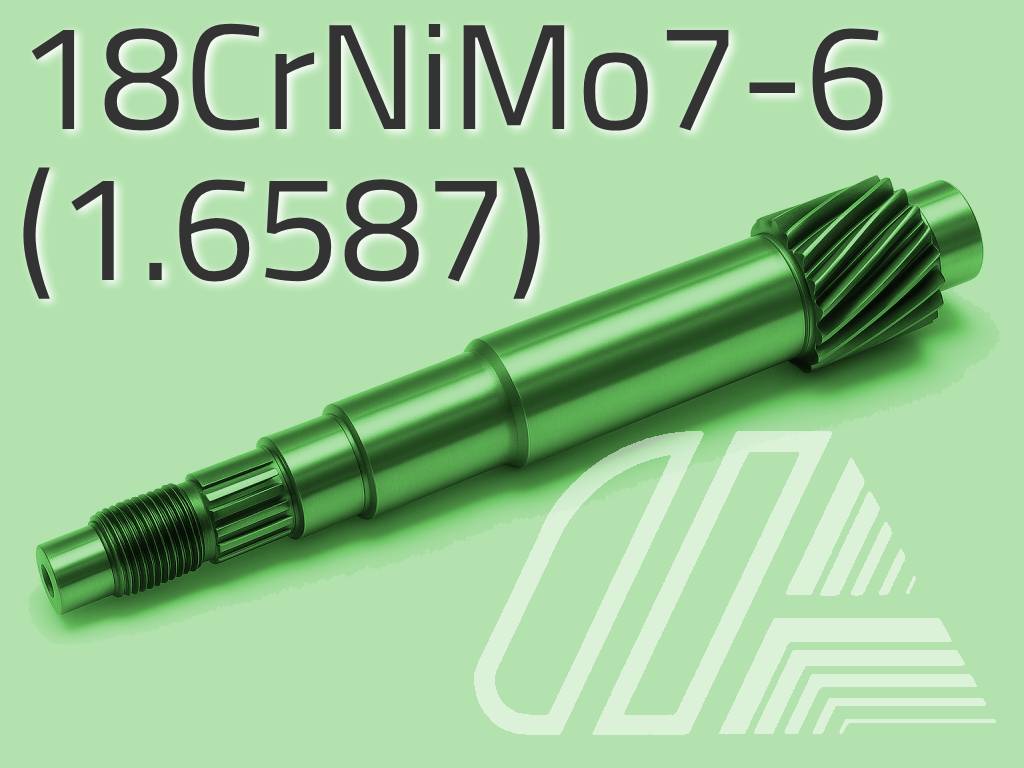18CrNiMo7-6 (1.6587)
ISO 683-3 / UNI 7846
Annealed (+A)
PROPERTIES AND APPLICATIONS

The characteristics of 18CrNiMo7-6 steel are:
High Hardenability and Hardening Depth: Thanks to its significant chromium, nickel, and molybdenum content, 18CrNiMo7-6 steel exhibits excellent hardenability, allowing for deep and uniform hardening even in large components. This property is crucial for ensuring consistent mechanical properties across significant sections, a critical requirement for parts subjected to complex stresses.
Exceptional Wear and Fatigue Resistance: The combination of an extremely hard surface (obtained after carburizing and quenching) and a tough core gives this steel superior wear resistance and good fatigue strength. These properties are essential for components subjected to repeated loading cycles, intense friction, and abrasion.
Optimal Combination of High Surface Hardness and Core Toughness: This is the distinctive characteristic and primary advantage of carburizing steels. The surface, carbon-enriched during carburizing and subsequently hardened, achieves high hardness values (58-62 HRC) to resist wear and surface deformation, while the core remains tough and impact-resistant.
Good Machinability: Despite its inherent strength and metallurgical complexity, 18CrNiMo7-6 steel is considered relatively easy to machine in its annealed state, which facilitates production processes.
18CrNiMo7-6 steel is inherently designed to have a "dual nature": an extremely hard surface and a tough core. Its mechanical properties vary drastically between the as-supplied condition (e.g., annealed, <229 HBW) and the final condition after carburizing and quenching (surface 58-62 HRC). This is not a limitation but an inherent characteristic achieved through a specific and controlled heat treatment process. This "dual nature" implies that the component's final performance critically depends on the correct execution of each stage of the heat treatments.
Applications of 18CrNiMo7-6 steel are concentrated in high-stress sectors, including: Automotive / Aerospace / Energy / Heavy Machinery / Naval Industry / Oil Industry.
Typical components made from this steel include: gears, drive shafts and axles, gear shafts, spindles and axles, where high strength and durability are required in demanding rotational applications, wear pins, pinions, wire guides, valve stems, cam parts, and clutch components.
CORRESPONDENCE TO INTERNATIONAL DESIGNATIONS
| QUALITY | EUROPE | GERMANY | FRANCE | SPAIN | G.B. | USA | |
|---|---|---|---|---|---|---|---|
| EN | DIN | W.n. | AFNOR | UNE | B.S. | AISI/SAE | |
| 18CrNiMo7-6 | 18CrNiMo7-6 | 17CrNiMo6 | 1.6587 | 18CND6 | 820A16, ~822M17 | ~4815, ~4820 | |
CHEMICAL COMPOSITION % (EN 10084)
| STEEL DESIGNATION | CHEMICAL COMPOSITION | |||||||||
|---|---|---|---|---|---|---|---|---|---|---|
| SYMBOLIC | NUMERIC | C | Si max | Mn | P max | S max | Cr | Mo | Ni | B |
| 18CrNiMo7-6 | 1.6587 | 0,15 ÷ 0,21 | 0,40 | 0,50 ÷ 0,90 | 0,035 | 0,035 | 1,50 ÷ 1,80 | 0,25 ÷ 0,35 | 1,40 ÷ 1,70 | - |
CONCENTRATION LIMITS OF THE ELEMENTS THAT ARE NOT INDICATED IN THE TABLE CAN BE DEDUCED IN THE EN 10020 REGULATION. IT CAN BE PROVIDED WITH AN ADDITION OF LEAD 0,12-0,35% OR SULPHUR CONTROLLED UP UNTIL 0,40% FOR AN IMPROVED MACHINABILITY.
JOMINY HARDENABILITY (EN 10084)
| STEEL DESIGNATION | RANGE LIMITS | HRC HARDNESS MEASURED FROM THE QUENCHED END OF THE TEST TUBE (MM) | |||||||||||||
|---|---|---|---|---|---|---|---|---|---|---|---|---|---|---|---|
| SYMBOLIC | NUMERIC | 1,5 | 3 | 5 | 7 | 9 | 11 | 13 | 15 | 20 | 25 | 30 | 35 | 40 | |
| 18CrNiMo7-6+H | 1.6587 | max | 48 | 48 | 48 | 48 | 47 | 47 | 46 | 46 | 44 |
43 |
42 | 41 | 41 |
| min | 40 | 40 | 39 | 38 | 37 | 36 | 35 | 34 | 32 | 31 | 30 | 29 | 29 | ||
USUALLY AVAILABLE EX STOCK
| M.T. COLORATION | QUALITY | HEAT TREATMENT | SURFACE | DIAMETER(mm) |
|---|---|---|---|---|
 |
18CrNiMo7-6 | Soft-annealed (+A) | rolled forged turned |
30-300 310-520 |






